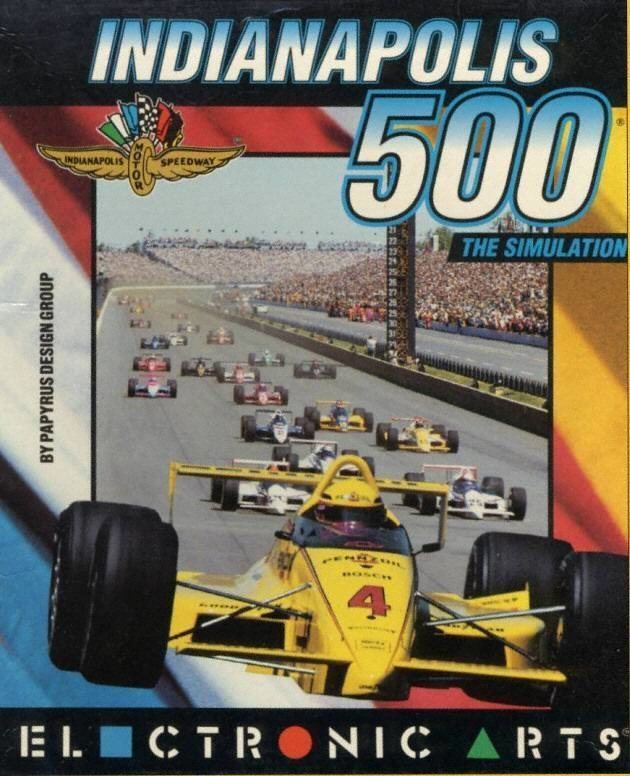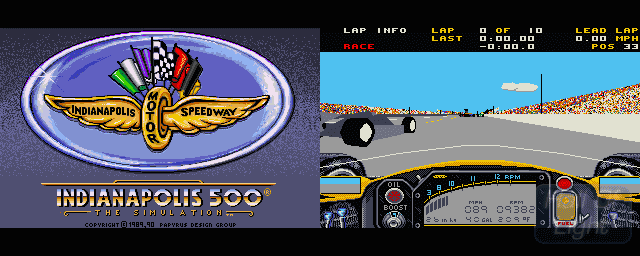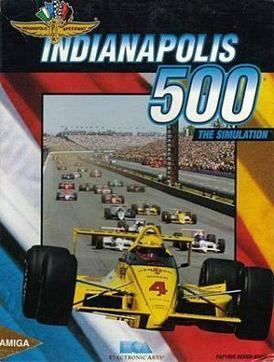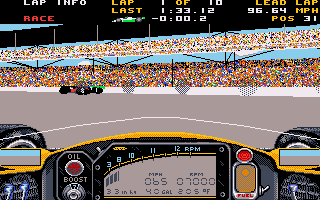9.2 /10 1 Votes9.2
| 4.6/5 My Abandonware Initial release date 1989 | |||||||||||||||||||||||||||||||||
 | ||||||||||||||||||||||||||||||||||
Designer(s) David KaemmerOmar Khudari Similar Papyrus Design Group games, Racing video games | ||||||||||||||||||||||||||||||||||
indianapolis 500 the simulation 1989 intro pc roland mt 32 munt vs amiga a500
Indianapolis 500: The Simulation is a 1989 computer game. It was hailed as the first step of differentiating racing games from the arcade realm and into racing simulation. It was developed by the Papyrus Design Group, consisting of David Kaemmer and Omar Khudari, and distributed by Electronic Arts. It first released for DOS and later for the Amiga in 1990.
Contents
- indianapolis 500 the simulation 1989 intro pc roland mt 32 munt vs amiga a500
- Overview
- Car setup
- Replay mode
- Crashes and retirements
- Commodore Amiga version
- Reception
- References

Indianapolis 500: The Simulation attempts to be a full simulation of the Indianapolis 500 race, with 33 cars and appropriate Indy car "feel". While racing, it only offers a first-person perspective, but the game offers a replay mode as well. Indy 500 offers the ability to realistically set up the car, and any changes made to the car directly affect how it handles.

The field is represented as realistic and the qualifying order stays true to the 1989 Indianapolis 500 starting grid, with one exception: the player's car, numbered 17, replaces Car #29 of Rich Vogler, who qualified in 33rd and last place.

Overview
The game offers four race settings:

There are also practice and qualifying settings. Practice enables car setups to be altered and tested in real time. Choosing not to participate in the qualifying session results in one starting at the back of the field. The qualifying session requires four laps to be completed, with the mean value of the four lap times determining the qualifying position. No car damage can occur during a Practice session, although other cars may be present on the track and their wreckage remains on the track if the player's car collides with them at any point. Car damage can occur during qualifying sessions.

The cars one can drive are a yellow Penske-Chevrolet, a red Lola-Buick, or a blue March-Cosworth, with the Penske having the fastest default setup (but if one sets the car up well, any of the above racecars can compete effectively). Various settings can be changed during Practice from menus associated with Function keys F3–F10. One's own car is always numbered 17.

Indy 500's theme music was produced by Rob Hubbard, who at the time was new to Electronic Arts as a music director.
Car setup
A wide and realistic variety of car settings can be altered during Practice in order to change car performance. In Practice mode, changes take immediate effect, making comparisons between even the slightest changes straightforward, and any number of "testing" laps can be driven (all of which are timed, again helping comparisons to be made). During Qualifying and Race sessions, however, no settings except Turboboost and the anti-roll bars can be altered except while stopped in the pits, and some settings are unchangeable even then.
Replay mode
Six camera angles are available: In-Car, Behind, Track, TV, Sky, and Leader. The replay mode offers the chance to review the previous 20 seconds of racing.
Crashes and retirements
The 32 computer-controlled cars can crash at any point in the race, or retire with mechanical problems during pit stops. In a 10-lap race, a crash causes a yellow flag to flash briefly in the top left of the screen, but all cars continue racing at full speed as if still under "green-flag" conditions. In all other race distances, yellow flags flash, cars slow down and are forbidden from passing until the incident is cleared. A crashed car typically stays on the circuit for 2–3 laps before being cleared, after which green flags flash as the leader exits turn 4, signalling that cars may continue racing. No yellow flags are shown if one's own car crashes, unless other cars hit the wreckage. During a yellow flag period, speeds are restricted to approximately 90 mph (against a typical race pace of up to 230 mph).
One's own car cannot be damaged by crashes in 10-lap or 30-lap races. In the longer races, excessively hard contact with a wall, fence or another car can cause wheel and/or engine damage. It is still possible to recover to the pits after damaging one front wheel, though the car is more difficult to control. Destruction of any two tires makes recovery extremely difficult, and in most cases impossible. A very large impact, especially to the rear of the car, may cause engine damage, from which there is no recovery. After being involved in a crash, computer-controlled cars are shown as "Crashed" in the Standings screen.
Retirements may also occur due to mechanical problems. If a car suffers mechanical problems, it will pull into the pits and remain there for the rest of the race. The problem that caused the car to retire are shown on the standings screen. Possible causes of retirement are: Bearing, Clutch, CV Joint, Engine, Gearbox, Ignition, Stalled, Valve, Vibration, Radiator and Oil Leak. Again, this only applies to computer-controlled cars; the player-controlled car does not suffer from random failures.
There is the ability to blow the engine if it goes too high in revs.
Commodore Amiga version
An Amiga version of Indy 500 was released in late 1990. It ran from a single floppy disk, and was copy-protected using a simple manual-based question-and-answer method common with many other games of the period.
The game was identical to the MS-DOS version except in minor details. For example, an error in programming resulted in there being two cars numbered 20; in the MS-DOS version, one of these was numbered 12, correctly reflecting the 1989 Indianapolis 500 grid. Certain minor bugs were removed.
One instant replay could be saved to disk, as could up to three car settings. However, partly completed races could not be saved. Car control was via mouse, joystick or keyboard; mouse gave a particularly smooth, natural driving feel, and mouse sensitivity could be customised from the main menu.
Replays were only available to those with the optional 512KB ram upgrade installed (normally, Commodore's own "A501").
Reception
Auto racer Barry Werger praised the game's graphics, controls, and realism in Computer Gaming World. He described it as a "hyper-realistic simulation [and] a valuable educational tool", and advised casual racers uninterested in running many laps to test each change to the racecar's design to "stick to Out Run". The Amiga version was voted the 9th best game of all time in Amiga Power.
